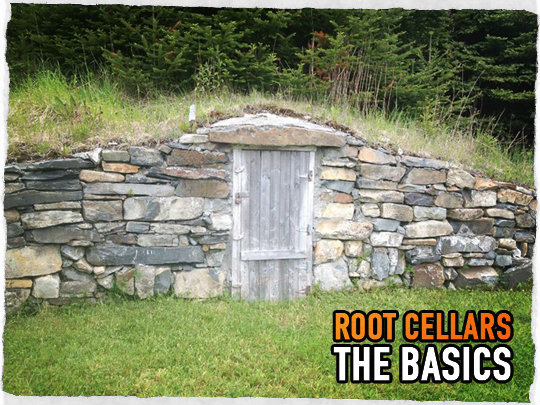
Depending on where you live in the world, you can expect a nearly constant temperature of between 50 and 60ᵒ F (10-16ᵒ C) at between 4 and 15 feet below ground level. Below 20 feet, the temperature is equal to the mean annual air temperature at that latitude.
Did you get all that, in other words, a root cellar, with everything else being equal, dug at between 4 and 15 feet below ground level will act as a chiller for produce and other perishable items. Below ground can also mean dug into the side of a hill.
Note: In some areas of the country, a depth of 4 feet will give you a constant yearly average temperature of between 50 and 60ᵒ F. depending on the mean annual temperature.
In some parts of the country the frost/freeze line is at a depth of 3 feet or more, which means water pipes can freeze at this depth in the winter, so before digging do some research on your area for your mean annual air temperature.
Getting Started
In years past, root cellars were usually dug into the side of a hill or even under a portion of the house in some cases. Once dug they were then shored up with fieldstones and/or timbers and a door was, added if dug into the side of hill, to keep varmints and humans out and to help maintain a constant temperature. The cellars usually had one, two or more ventilation shafts as well. The floor was typically crushed gravel or even sand.
To maintain the proper storage or “living” conditions for your produce at least three things need to be considered and they are temperature, humidity and ventilation.
Today you can excavate a cave in the side of a hill, and shore it up with stone or blocks or even convert a portion of your basement. You can also excavate a hole essentially straight down, create steps out, then cover the top with timbers, or iron beams, sheets of plywood or metal, and then cover with the excavated soil. The interior walls would need to be shored up and some type of drainage system would likely need to be added. Cinderblocks would be ideal for your root cellar walls.
If you dig your cellar straight down, you would need to backfill between the block walls and the earth walls for drainage. Otherwise, your cellar will collect groundwater. You may have to trench around the sides, lay perforated tubing, and slope the floor slightly for drainage as well. You can use limestone chips or some other suitable gravel as a backfill medium.
The floor can be gravel over dirt or even sand. Having a concert floor would make it more difficult to control the moisture level. You will need ventilation to help deal with excessive humidity and to help control the temperature, and to provide sufficient oxygen for anyone working in the cellar. Ventilation can be PVC piping or piping of your choice. The ventilation shaft (s) exposed above ground would need to be screened and hooded/capped to prevent animals and rain from getting in. You need a way of adjusting the airflow, so a controllable ventilation grate attached to the tubing inside the cellar would be ideal.
More On Ventilation, Because It Is More Important Than Some May Realize
Fresh produce will emit ethylene gas, which helps ripen the produce. Proper ventilation will help disperse the gas away from the produce to prevent rapid ripening and/or spoilage. The bigger the root cellar the more ventilation is required. Ventilation is needed to replenish oxygen levels and to remove heat as well. Do not overlook this important aspect of any underground shelter or root cellar.
Remember warm air rises and cool air settles.
Root cellars do need high humidity levels, and some experts recommend it be between 80 and 90 percent, but you do not want water forming on the walls or on the shelving or product stored down there.
The humidity prevents root vegetables and fruits such as apples and pears from shriveling up. This is why having a way to adjust the airflow is important. The cellar needs a secure and insulated door that can be easily propped open if need be.
Leafy crops store best at humidity levels above 80 percent. Root vegetables also need high humidity, while onions, garlic and winter squash for example are best stored at 60 percent humidity or below. You can add moisture to your cellar by sprinkling water on the floors and walls.
Certain produce can be “cured” before being placed in storage for over the winter. Cure winter squash, onions, potatoes and garlic at temperatures between 80 and 90ᵒ F for 10 days before placing in your root cellar.
You can get as elaborate as you want when building your cellar or for a quick and temporary cellar, you can bury a 50-gallon plastic water barrel for storage of produce.
Use wooden shelves instead of metal ones because metal conducts heat or cold much more easily than wood. Use slatted shelving for better air circulation.
In cold areas of the country you would have the entrance facing south to southeast while in moderate climates have the entrance facing north so you can open the door to adjust the temperature if needed.
If you dig your cellar into the side of a hill make sure the floor is elevated, and sloped slightly above the outside ground so if you experience heavy rains the water will run off.
Canned goods even ones you canned yourself cannot be stored in a root cellar because the humidity would rust the cans and metal lids on glass canning jars. Obviously, any material that is susceptible to moisture damage should not be stored in a root cellar.